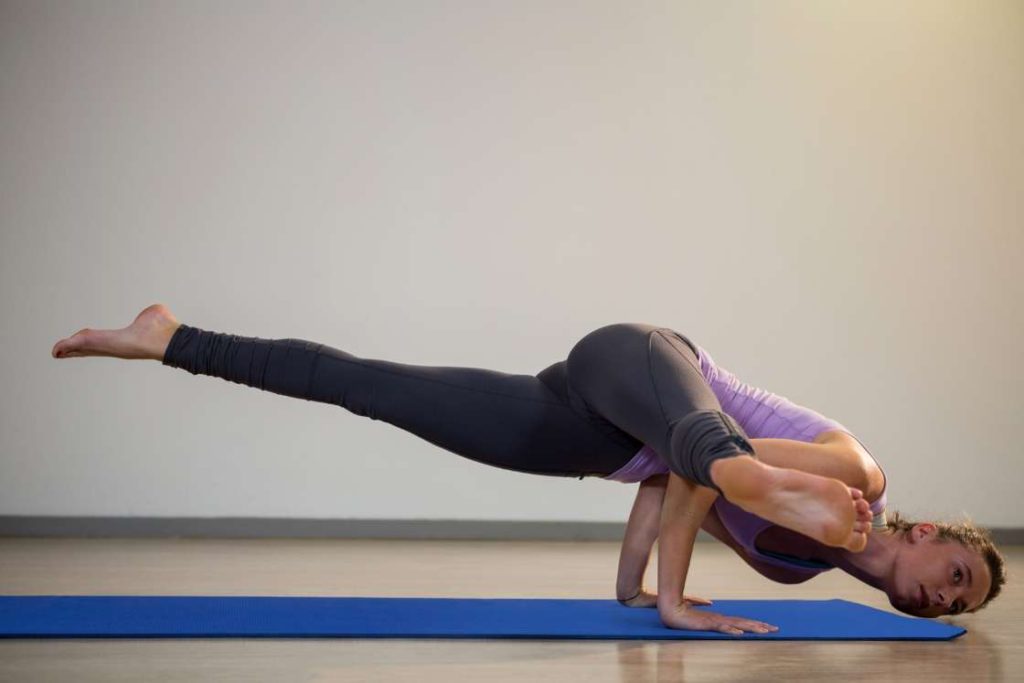
| Sanskrit Pronunciation | Eka Pada Koundinyasana I (EY-kuh Pah-duh kown-din-YAHS-ah-nuh) |
| Meaning | Eka = one / Pada = foot / kondinya = a sage / asana = pose |
| Pose Type | Side Twisting and Balancing |
| Pose Level | Advanced pose |
| Stretches | Quadriceps, Lower Back muscles, hips, hamstrings, thighs, neck, wrist, palms, forearms and shoulder, torso, spine, core |
| Other Names | Eka Pada Koundinyasana I, One foot sage pose, Sage koundinya’s Pose I |
Eka Pada Koundinyasana is an advanced pose that combines balancing and twisting of the body at the same time. In this pose, the body is lifted on the side upper arm and then the legs are split apart in the final position of the pose.
The skill required to practice this pose can be achieved by the practice Bakasana (Crow Pose) and Parsva Bakasana (Side Crow Pose).
Meaning
Eka Pada Koundinyasana is one of the asanas named after a sage yogi Koundinyasana. Eka means one, Pada means Foot. The pose is also called “one-foot sage pose” or “Sage Koundinya’s pose”.
Kaundinya was the scholar of the royal court of king Suddodhana. He once predicts the birth of Siddhartha who later become the Buddha, as he achieved enlightenment. Practicing Eka Pada Kondinyasana, hence, guides the practitioners to the enlightenment.
Practice Guide
To practice Eka pada koundinyasana safely, one can follow the given steps. This will help you in the thorough practice of the pose.
Contraindications
Avoid practicing Eka pada koundinyasana in wrist, elbow, and shoulder injury. Do not proceed in case of lower back pain and abdominal surgery.
Moreover, women under pregnancy and menstruation cycle should not practice Eka Pada Koundinyasana. It is also not to keep up with conditions like high blood pressure and hernia.
Preparatory Pose
- Utthita Hasta Padangushthasana (Standing Big Toe Hold)
- Hanumanasana (Monkey Pose)
- Parsva Bakasana (Side crow Pose)
How to Do Eka Pada Koundinyasana I (Steps)
- Begin by coming into a squatting position and then turn on any side to face the side of the mat. Now, remain on your feet’ balls and lean forward to place your hands flat on the floor.
- Now, place your feet so that your knees facing the left side of your body. Then, by keeping head up lean forward.
- After that, bend your elbows at 90 degrees and simultaneously press into the palms to form a shelve.
- From here, place the side of your right knee on the shelve created by the left hand. Now, to prepare the lifting of the feet shifts your weight forward.
- Now, exhale to take your left leg straight in the back direction and right leg in the forward direction. Feel the stretch in the groin and keep the feet flexed throughout the pose. Keep the gaze in the front direction.
- Maintain here for some time and then return lowering the legs and releasing the pressure from the palms. Afterward, perform the same step with the other side.
Follow up Poses
Precautions
Eka Pada Koundinyasana I is one of the challenging poses for many practitioners. Follow these precautions while doing the pose;
- Don’t let your sternum collapse forward – while lifting your body in this pose, align your shoulder with elbows so you don’t fall forward and collapse your sternum.
- Don’t come out of the pose jerkily – Avoid returning from the twisted position with a jerk due to uneven distribution of the weight on the palms. This could be injurious to the wrist and shoulder.
- Place your knee carefully on elbows – Do not try to place your side of the knee just on the elbows, this might result in falling off the set of the folded legs to the floor. Practitioners should keep them as above as possible from the elbow or on the ridge formed. This ensures the proper going and coming back from the pose.
Beginners Tips
- Beginners should refrain from directly getting into the pose due to the high demand for strength and flexibility. To tackle this, one should warm up their body properly with the Bakasana (Crow Pose) and Parsva Bakasana (Side Crow Pose). This will helps in opening the hips, core, and hamstring prior to the eka pada koundinyasana practice.
- Beginners with a history of migraine and asthma should go slow and easy into the pose. Because Eka Pada Koundinyasana requires twisting of the torso. This might cause difficulty in breathing due to squeezing of the chest and the abdomen. Hence, one should not force the pose in any manner.
- Keep your elbows at an angle of 90 degrees. This is will gives stable support to the pose. Also, one can wrap a strap around the elbows to prevent swaying of it while being in the pose. This is the main reason for the falling of the head down on the floor due to losing the balance.
Variations
Practitioners who have achieved mastery in the Eka Pada Koundinyasana can go for the variations. These are the Eka Pada Koundinyasana II and the eka pada Galvasana.
1. Eka Pada Koundinyasana II (The Hurdler Pose)
In this variation of the Eka pada Koundiyasana I, the body is balanced on the palms, and both legs are extended away from each other.
To get into this pose, from chaturanga dandasana place your one leg on the ridge of the respective side hand and other is stretched backward, along with the forward leaning of the torso.
2. Eka Pada Galvasana (Flying Pigeon Pose)
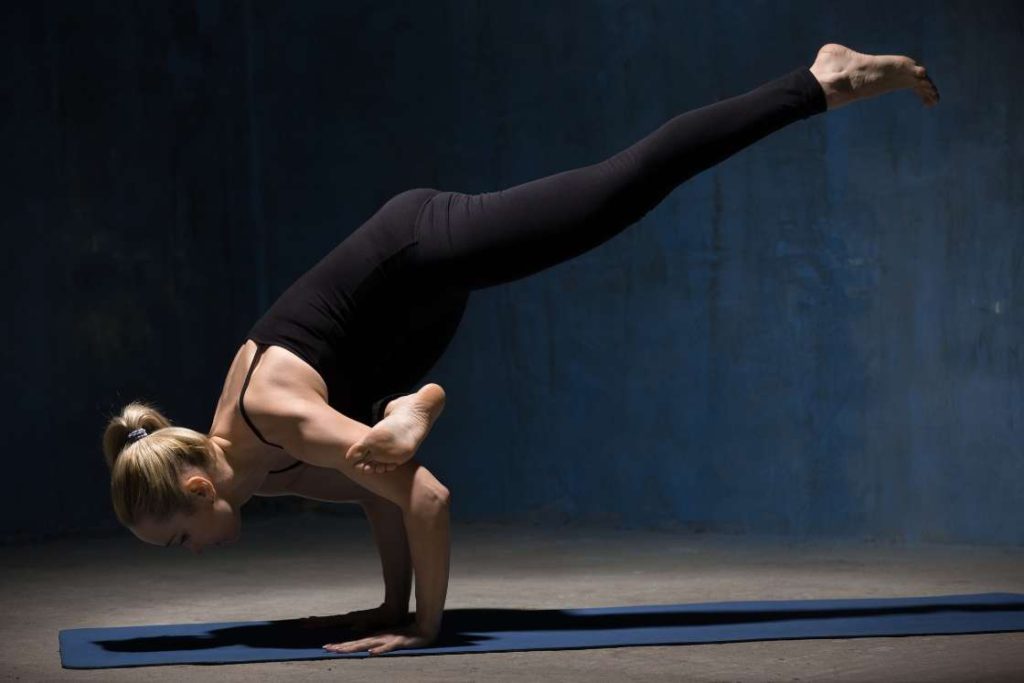
In the second variation of the Eka Pada Koundiyansana, the upper body is in the same position as the base pose. Also, it requires you to round your low back like in a cat stretch as you come into the pose.
To get into this pose, from chaturanga dandasana one leg is extended in the back direction and the other is tucked under the torso on the ridge formed by the opposite arm.
Therapeutic Benefits
- Cures lower Back Pain – The Practice of Eka pada Koundinyasana I strengthens the lower back can help alleviate and prevent lower back pain. It also strengthens the core, leg, and arm muscles. However, by increasing the blood flow to the concerning region this asana reduces the stiffness in the back and speeds up the healing process.
- Helps in Headache and Migraines – Practicing Eka pada koundinyasana I releases endorphins, which body’s natural painkillers. Apart from that, it also alleviates the stress that grants better sleep to the practitioners. In fact, stress and inadequate sleep are the two migraine triggers.
Benefits of Eka Pada Koundinyasana I
The regular practice of the Eka pada Koundinyasana improves various bodily functions that add on to lifelong benefits. Following are some of them:
1. Improves Sense of Balance
The Eka pada koundinyasana practice improves the sense of balance [efn_note] How does our sense of balance work? https://www.ncbi.nlm.nih.gov/books/NBK279394/ [/efn_note] in the practitioners. Balancing in this asana strengthens the muscles that help in keeping you upright, including your legs and core. According to one of the studies [efn_note] Poststroke Balance Improves With Yoga https://www.ahajournals.org/doi/full/10.1161/STROKEAHA.112.658211 [/efn_note], it also helps in poststroke balance.
2. Revitalize Digestive organs
The sideway squeezing of the torso put pressure on the abdomen. This increases the blood flow to the muscles in the digestive system. This massages our food along the digestive tract. Hence, revitalizes digestive organs.
3. Strengthens the spine
According to one of the research [efn_note] Yoga, Vertebral Fractures, and Osteoporosis: Research and Recommendations https://meridian.allenpress.com/ijyt/article/23/1/17/137853/Yoga-Vertebral-Fractures-and-Osteoporosis-Research [/efn_note], Twisting in the Eka Pada Koundinyasana involves a combination of mild spinal flexion and extension. This along with moderate weight-bearing of the upper body in this asana strengthens the muscles supporting the spinal column. This in turn promotes balance and improves posture.
5. Activates Manipura Chakra
The regular practice of the Eka Pada Koundinyasana activates stimulates prana flow at the naval region during the twisting and squeezing of the torso. This results in the activation of the Manipura (Navel) chakra. When practiced done under the guidance of a well-experienced yoga teacher along with appropriate breathing techniques and alignment.
4. Improve quality of Life
As per the result of one of the studies [efn_note] Exploring the therapeutic effects of yoga and its ability to increase quality of life https://www.ncbi.nlm.nih.gov/pmc/articles/PMC3193654/ [/efn_note], yogic practices like Eka Pada Koundinyanasana enhance muscular strength and body flexibility promote and improve respiratory and cardiovascular functions. Moreover, it also promotes recovery from addictions, reduces stress, anxiety, depression, and chronic pain, sleeps patterns, and enhances overall being and quality of life.
6. Strengthens Upper Body
The Eka Pada Kondinyasana involves balancing on the arms. This creates immense pressure throughout the upper body. This increases blood circulation that further ensures the better growth of muscles and bones in that region. This further adds to good posture, weight loss, body balance and strength, aesthetics.
Conclusion
The Eka Pada Koundinyasana is an effective yoga pose that strengthens the upper body, stimulates internal organs, and promotes a sense of balance in different age groups with a good grasp of hand balancing.
This is a challenging asana, so, the beginners avoid directly practicing this pose. One should always listen to his/her body and perform a warm-up prior to the posing practice.
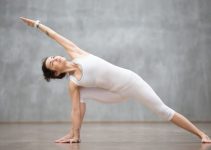

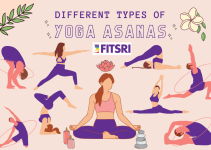
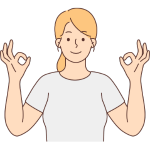
 Oct 27th to 2nd Nov
Oct 27th to 2nd Nov Learn Mudras
Learn Mudras  Deepen Your Practice
Deepen Your Practice  Find Inner Peace
Find Inner Peace